Cell Wall and Endomembrane System | Biology for ACT PDF Download
Cell Envelope and its Modifications
(i) Prokaryotic cells, especially bacteria, feature a complex cell envelope comprising three tightly bound layers:
- Glycocalyx: The glycocalyx varies in composition and thickness, with some bacteria having a slime layer and others forming a capsule.
- Cell wall: The cell wall shapes the cell and provides structural support.
- Plasma membrane: Selectively permeable, interacts with the external environment and resembles that of eukaryotes.
- Mesosomes: mesosomes are formed by plasma membrane extensions, play roles in cell wall formation, DNA processes, respiration, and increasing membrane surface area.
(ii) These layers, while distinct, function together as a protective unit.
(iii) Bacteria are categorized as Gram-positive (retain Gram stain) or Gram-negative (do not retain Gram stain) based on their cell envelope differences.
Note: Bacteria are categorized as either Gram-positive or Gram-negative based on their cell envelope structure and response to a staining procedure called the Gram stain:
- Gram-Positive Bacteria: They have a thick peptidoglycan layer in their cell wall that retains the stain, making them appear purple when stained.
- Gram-Negative Bacteria: They have a thinner peptidoglycan layer and an outer membrane that does not retain the stain, causing them to appear pink or red after staining
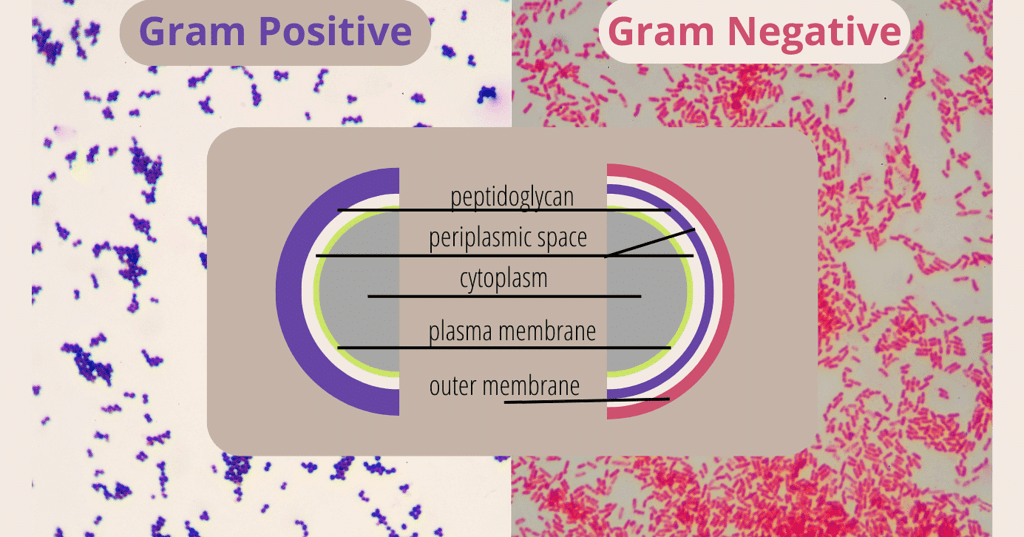 Gram-positive & Gram-negative
Gram-positive & Gram-negative
- Chromatophores: Pigment-containing structures found in various cells.
- Bacterial Cell Mobility: Bacterial cells can be either motile or non-motile.
- Flagella: Thin, filamentous extensions from the cell wall of motile bacteria.
- Composed of three parts: filament, hook, and basal body.
(i) Filament is the longest part and extends outside the cell.
(ii) Pili (Pilus, Singular): Elongated tubular structures made of a specialized protein.
(iii) Fimbriae: Small, bristle-like fibers on the surface of bacterial cells.
Ribosomes and Inclusion Bodies
Location: Prokaryotic ribosomes are found at the cell's plasma membrane.
Size: They are about 15 nm by 20 nm in size and consist of 50S and 30S subunits, forming 70S ribosomes.
Function: These ribosomes are where protein synthesis takes place, and multiple ribosomes can attach to one mRNA, forming polysomes.
Inclusion Bodies
Storage: Prokaryotic cells store reserve materials as inclusion bodies in the cytoplasm.Characteristics: Inclusion bodies are not enclosed by membranes and include materials like phosphate, cyanophycean, and glycogen granules.
(c) Gas Vacuoles
Presence: Gas vacuoles are found in specific photosynthetic bacteria, such as blue-green and purple-green varieties.
- Primary and Secondary Wall: The primary wall of a young plant cell is capable of growth, which gradually diminishes as the cell matures, and the secondary wall is formed on the inner (towards membrane) side of the cell.
1. Cell Wall
The cell wall is a rigid, protective structure that surrounds the plasma membrane of plant cells, fungi, and some bacteria. It was first discovered by Robert Hooke in 1665.
The composition of cell walls varies depending on the type of organism. In plant cells, the primary component of the cell wall is cellulose, a complex carbohydrate made up of glucose molecules. Fungal cell walls contain chitin, while bacterial cell walls can be composed of peptidoglycan or other materials.
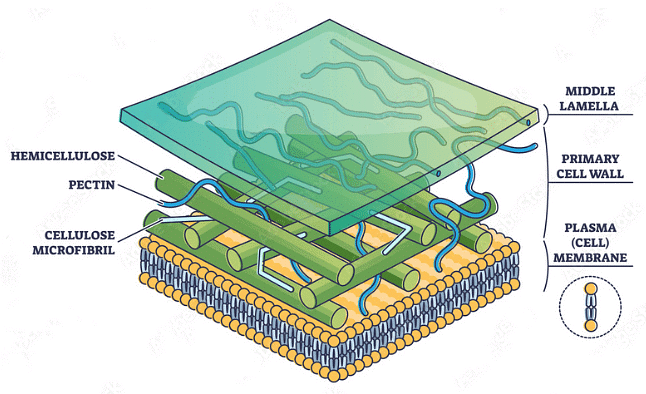 Components of Cell Wall
Components of Cell Wall
Components of Cell wall
- Cellulose is the primary structural component of the plant cell wall. It is a complex carbohydrate (polysaccharide) made up of glucose molecules linked together.
- Hemicellulose is another type of polysaccharide found in the plant cell wall. It helps in binding cellulose microfibrils together, contributing to the overall structural integrity of the cell wall.
- Pectin is a complex polysaccharide that is found in the middle lamella of plant cell walls. It acts as a cementing substance, holding adjacent cells together and helping to maintain the structure of tissues.
- Primary and Secondary Wall: The primary wall of a young plant cell is capable of growth, which gradually diminishes as the cell matures, and the secondary wall is formed on the inner (towards membrane) side of the cell.
- Middle Lamella: The middle lamella is a layer mainly of calcium pectate that holds or glues the different neighbouring cells together.
(i) Composition: The middle lamella primarily consists of pectin, a complex polysaccharide. Pectin molecules are rich in negatively charged ions and have the ability to form bonds with other pectin molecules. This adhesive quality of pectin makes the middle lamella effective in cementing adjacent cell walls.
(ii) Function: The primary function of the middle lamella is to hold plant cells together, especially in plant tissues. It ensures the structural integrity of the tissue by firmly joining the cell walls of neighboring cells.
(iii) Plasmodesmata: Plasmodesmata (singular: plasmodesma) are microscopic channels that traverse the cell wall and middle lamellae, connecting the cytoplasm of adjacent plant cells.
2. Cell Membrane
The cell membrane, also known as the plasma membrane, is a fundamental structural component of all cells in living organisms. It is a selectively permeable barrier that separates the interior of the cell from its external environment. The cell membrane plays several crucial roles in maintaining the integrity and function of the cell.
Every living cell is externally covered by a thin transparent electron microscopic, elastic regenerative and selective permeable membrane called plasma membrane.
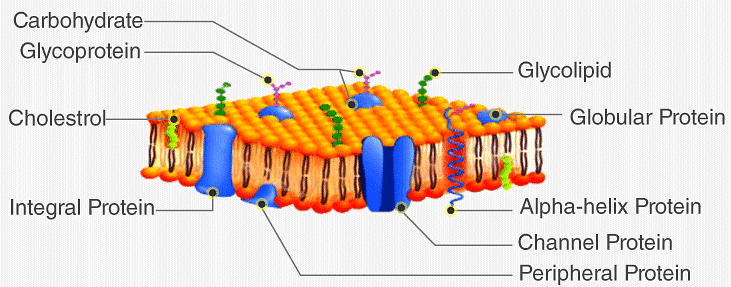 Cell Membrane
Cell Membrane
According to Singer and Nicolson, it resembles a "protein iceberg floating in a lipid sea."
- In plant cells, various microorganisms, some protists, and fungal cells, there exists an outer cell wall situated outside the plasma membrane.
- Membranes are also found within cells, and these are collectively referred to as biomembranes.
The term "cell membrane" was initially coined by C. Nageli and C. Cramer in 1855 to describe the outer membrane covering of the protoplast. However, the term "plasmalemma" or "plasma membrane" was introduced by Plowe in 1931 to replace "cell membrane."
Functions of Plasma Membrane
(i) Involved in Membrane Functions: Supports cell growth, intercellular junctions, secretion, endocytosis, and cell division. Selectively permeable for molecules on both sides. passive transport takes place.
(ii) Transfer of Molecules without energy: Simple diffusion for neutral solutes (from high to low concentration). Osmosis for water (movement by diffusion).
(iii) Active Transport: Requires energy (typically ATP). Moves ions or molecules against their concentration gradient. Example: Na+/K+ Pump.
What are Cell Organelles?
- More than 8.7 million species are living on the planet. Every single species is composed of a cell and it includes both single-celled and multicellular organisms.
- A cell is the basic structural and functional unit of a living organism. According to cell theory postulates, a cell is the basic building block of life, which makes anything alive and is self-sufficient to carry out all the fundamental functions of an organism.
- The cells provide shape, structure and carries out different types of functions to keep the entire system active. The cell contains different functional structures which are collectively called Organelles, and they are involved in various cellular functions.
The cellular components are called cell organelles. These cell organelles include both membrane and non-membrane bound organelles, present within the cells and are distinct in their structures and functions. They coordinate and function efficiently for the normal functioning of the cell. A few of them function by providing shape and support, whereas some are involved in the locomotion and reproduction of a cell.
Classification of Cell Organelles
There are various organelles present within the cell and are classified into three categories based on the presence or absence of membrane.- Organelles without membrane: The Cell wall, Ribosomes, and Cytoskeleton are non-membrane-bound cell organelles. They are present both in prokaryotic cell and the eukaryotic cell.
- Single membrane-bound organelles: Vacuole, Lysosome, Golgi Apparatus, Endoplasmic Reticulum are single membrane-bound organelles present only in a eukaryotic cell.
- Double membrane-bound organelles: Nucleus, mitochondria and chloroplast are double membrane-bound organelles present only in a eukaryotic cell.
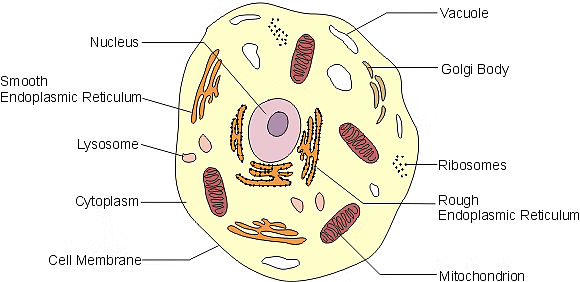 Cell Organelles
Cell Organelles
List of Cell Organelles and their Functions
1. Plasma Membrane
The plasma membrane is also termed a Cell Membrane or Cytoplasmic Membrane. It is a selectively permeable membrane of the cell, which is composed of a lipid bilayer and proteins.- The plasma membrane is present both in plant and animal cells, which functions as the selectively permeable membrane, by permitting the entry of selective materials in and out of the cell according to the requirement.
- In an animal cell, the cell membrane functions by providing shape and protecting the inner contents of the cell. Based on the structure of the plasma membrane, it is regarded as the fluid mosaic model.
- According to the fluid mosaic model, the plasma membranes are subcellular structures, made of a lipid bilayer in which the protein molecules are embedded.
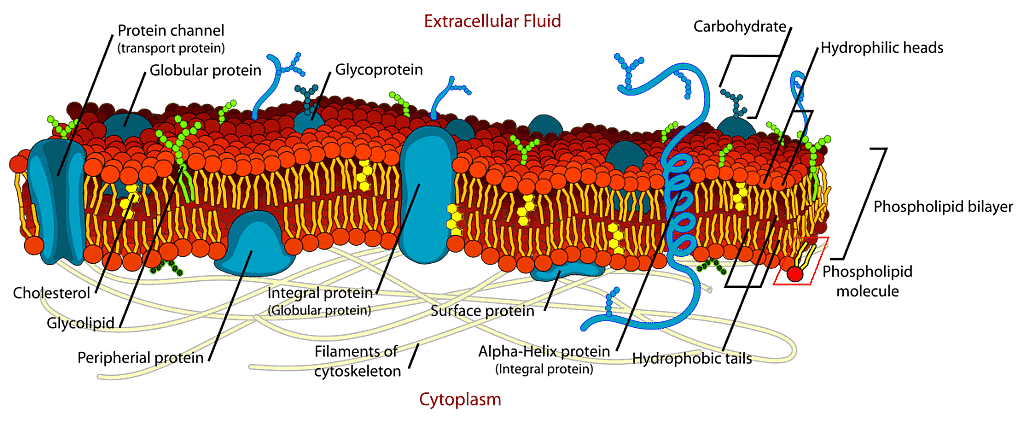 Fluid Mosaic Model
Fluid Mosaic Model
2. Cytoplasm
The cytoplasm is present both in plant and animal cells. They are jelly-like substances, found between the cell membrane and nucleus. They are mainly composed of water, organic and inorganic compounds.- The cytoplasm is one of the essential components of the cell, where all the cell organelles are embedded. These cell organelles contain enzymes, mainly responsible for controlling all metabolic activity taking place within the cell and are the site for most of the chemical reactions within a cell.
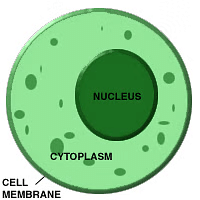 Cytoplasm
Cytoplasm
To practice the questions of "cytoplasm", attempt the tests given below:
3. Nucleus
The nucleus is a double-membraned organelle found in all eukaryotic cells. It is the largest organelle, which functions as the control centre of cellular activities and is the storehouse of the cell’s DNA.
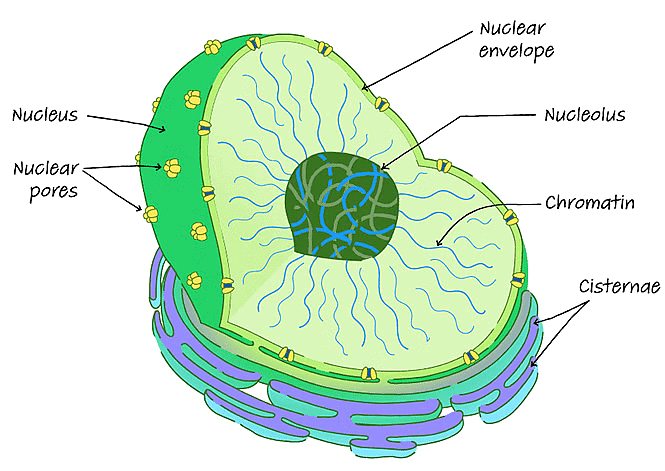 Structure of a nucleus
Structure of a nucleus
- By structure, the nucleus is dark, round, surrounded by a nuclear membrane. It is a porous membrane (like a cell membrane) and forms a wall between the cytoplasm and nucleus.
- Within the nucleus, there are tiny spherical bodies called the nucleolus. It also carries another essential structure called chromosomes.
- Chromosomes are thin and thread-like structures that carry another important structure called a gene. Genes are a hereditary unit in organisms i.e., it helps in the inheritance of traits from one generation (parents) to another (offspring).
- Hence, the nucleus controls the characters and functions of cells in our body. The primary function of the nucleus is to monitor cellular activities including metabolism and growth by making use of DNA’s genetic information.
- Nucleoli in the nucleus are responsible for the synthesis of protein and RNA.
To practice the questions of "Nucleus", you can attempt the test given below:
4. Endoplasmic Reticulum
The Endoplasmic Reticulum is a network of membranous canals filled with fluid. They are the transport system of the cell, involved in transporting materials throughout the cell. There are two different types of Endoplasmic Reticulum:(i) Rough Endoplasmic Reticulum – They are composed of cisternae, tubules, and vesicles, which are found throughout the cell and are involved with protein manufacture.
(ii) Smooth Endoplasmic Reticulum – They are the storage organelle, associated with the production of lipids, steroids, and are also responsible for detoxifying the cell.
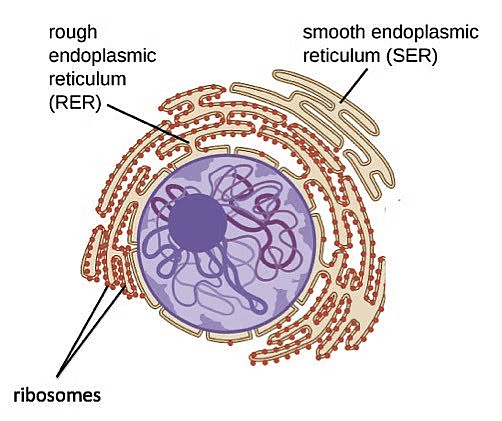 Endoplasmic Reticulum
Endoplasmic Reticulum
Question related to Endoplasmic Reticulum has been asked in NEET 2018
Q. Which of the following events does not occur in rough endoplasmic reticulum?
(a) Protein folding
(b) Protein glycosylation
(c) Cleavage of signal peptide
(d) Phospholipid synthesis
Ans. (d)
Smooth endoplasmic reticulum is involved in the production of lipids and sterols. Complexing of lipid and proteins to form lipoproteins occurs in SER. RER is involved in protein folding, glycosylation of protein and cleavage of signal peptide.
5. Mitochondria
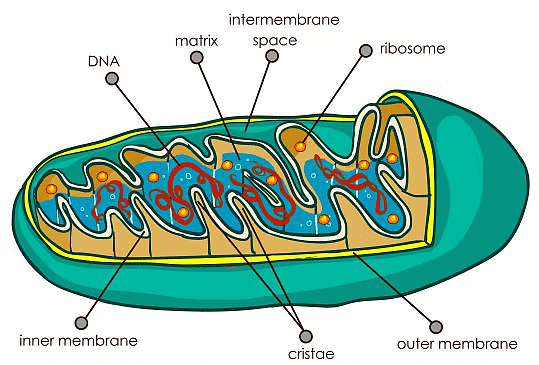 Mitochondria
Mitochondria
- Mitochondria are called the powerhouses of the cell as they produce energy-rich molecules for the cell. The mitochondrial genome is inherited maternally in several organisms. It is a double membrane-bound, sausage-shaped organelle, found in almost all eukaryotic cells.
- The double membranes divide its lumen into two distinct aqueous compartments. The inner compartment is called ‘matrix’ which is folded into cristae whereas the outer membrane forms a continuous boundary with the cytoplasm. They usually vary in their size and are found either round or oval in shape.
- Mitochondria are the sites of aerobic respiration in the cell, produces energy in the form of ATP and helps in the transformation of the molecules.
For instance, glucose is converted into adenosine triphosphate – ATP. Mitochondria have their own circular DNA, RNA molecules, ribosomes (the 70s), and a few other molecules that help in protein synthesis.
Question related to Mitochondria has been asked in NEET 2019
Q. Which of the following statements regarding mitochondria is incorrect?
(a) Mitochondrial matrix contains single circular DNA molecule and ribosomes.
(b) Outer membrane is permeable to monomers of carbohydrates, fats and proteins.
(c) Enzymes of electron transport are embedded in outer membrane.
(d) Inner membrane is convoluted with infoldings.
Ans. (c)
Enzymes of electron transport arc embedded in the inner membrane of mitochondria.
To practice the questions of "Mitochondria", you can attempt the test given below:
6. Plastid
Plastids are double-membrane organelles which are found in the cells of plants and algae. Plastids are responsible for manufacturing and storing of food. These often contain pigments that are used in photosynthesis and different types of pigments that can change the colour of the cell.Types of Plastids
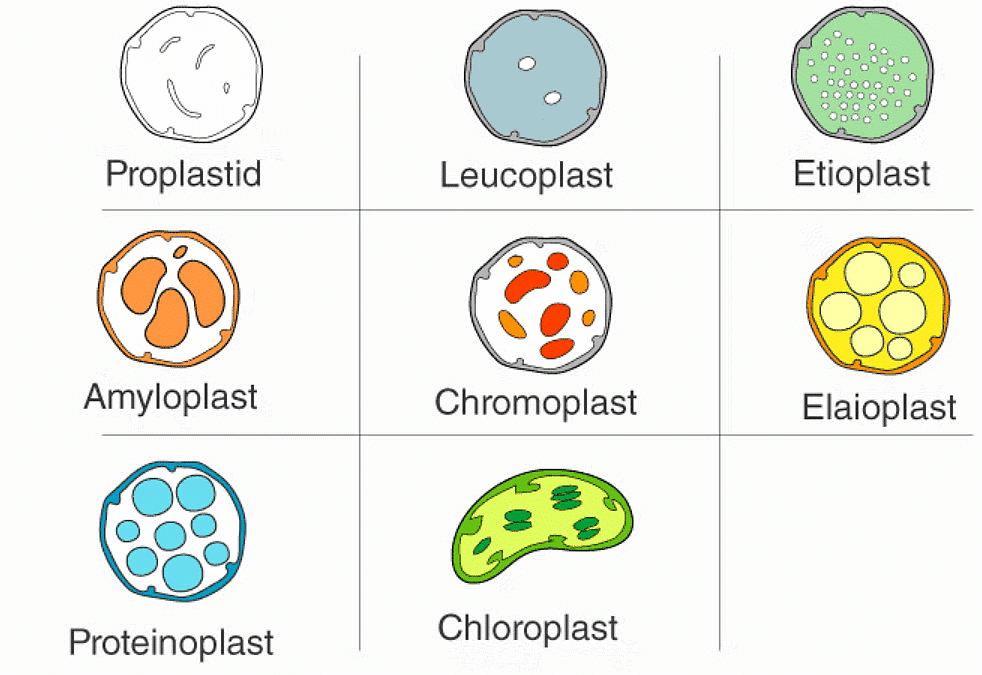 Types of Plastids
Types of Plastids
There are different types of plastids with their specialized functions. Among them, a few are mainly classified based on the presence or absence of the Biological pigments and their stages of development.(i) Chloroplasts
- Chloroplasts are double membrane-bound organelles, which usually vary in their shape from a disc shape to spherical, discoid, oval and ribbon.
- They are present in mesophyll cells of leaves, which store chloroplasts and other carotenoid pigments.
- These pigments are responsible for trapping light energy for photosynthesis.
- The inner membrane encloses a space called the stroma.
- Flattened disc-like chlorophyll-containing structures known as thylakoids are arranged in a stacked manner like a pile of coins.
- Each pile is called granum (plural: grana) and the thylakoids of different grana are connected by flat membranous tubules known as stromal lamella.
- Just like the mitochondrial matrix, the stroma of chloroplast also contains double-stranded circular DNA, 70S ribosomes, and enzymes required for the synthesis of carbohydrates and proteins.
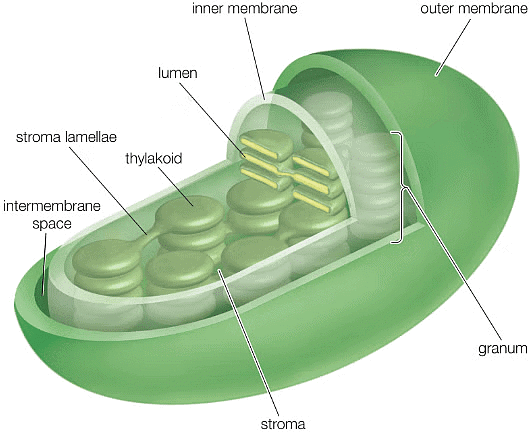 Chloroplast(ii) Chromoplasts
Chloroplast(ii) Chromoplasts
- The chromoplasts include fat-soluble, carotenoid pigments like xanthophylls, carotene, etc. which provide the plants with their characteristic colour – yellow, orange, red, etc.
(iii) Leucoplasts
- Leucoplasts are colourless plastids that store nutrients. Amyloplasts store carbohydrates (like starch in potatoes), aleuroplasts store proteins, and elaioplasts store oils and fats.
7. Ribosomes
 Cell Showing Ribosomes
Cell Showing Ribosomes
- Ribosomes are nonmembrane-bound and important cytoplasmic organelles found in close association with the endoplasmic reticulum.
- Ribosomes are found in the form of tiny particles in a large number of cells and are mainly composed of 2/3rd of RNA and 1/3rd of protein.
- They are named as the 70s (found in prokaryotes) or 80s (found in eukaryotes) The letter S refers to the density and the size, known as Svedberg’s Unit. Both 70S and 80S ribosomes are composed of two sub-units.
- Ribosomes are either encompassed within the endoplasmic reticulum or are freely traced in the cell’s cytoplasm.
- Ribosomal RNA and Ribosomal proteins are the two components that together constitute ribosomes.
- The primary function of the ribosomes includes protein synthesis in all living cells that ensure the survival of the cell.
8. Golgi Apparatus
Golgi Apparatus is also termed as Golgi Complex. It is a membrane-bound organelle, which is mainly composed of a series of flattened, stacked pouches called cisternae.- This cell organelle is primarily responsible for transporting, modifying, and packaging proteins and lipids to targeted destinations.
- Golgi Apparatus is found within the cytoplasm of a cell and is present in both plant and animal cells.
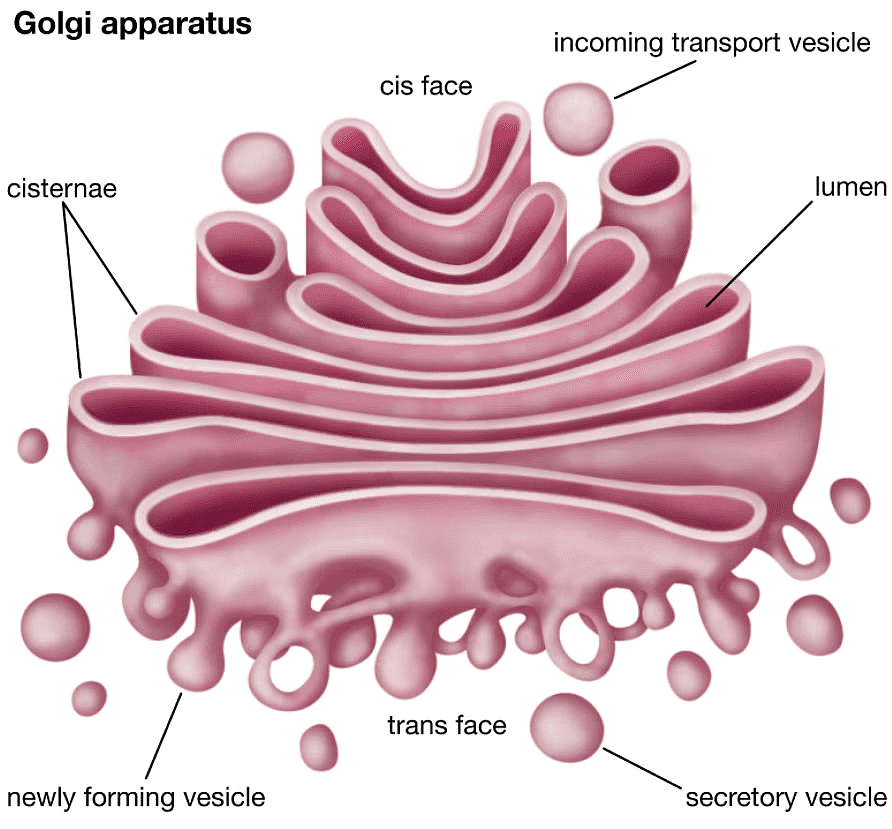 Golgi Apparatus
Golgi Apparatus
Question-related to Golgi Bodies has been asked in NEET 2020Q. Which is the important site of formation of glycoproteins and glycolipids in eukaryotic cells? (2020)
(a) Golgi bodies
(b) Polysomes
(c) Endoplasmic reticulum
(d) Peroxisomes
Ans. (a) Golgi Bodies
Proteins and lipids are formed in the endoplasmic reticulum and some of them are modified to form glycoproteins and glycolipids in the Golgi apparatus.
9. Microbodies
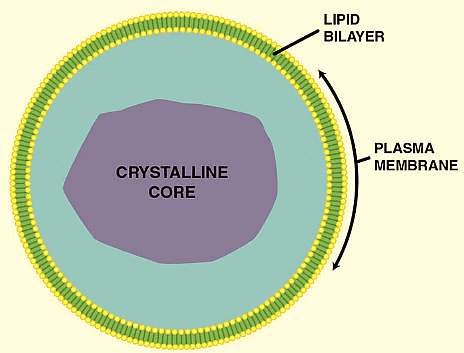 Microbodies
Microbodies
- Microbodies are membrane-bound, minute, vesicular organelles, found in both plant and animal cells.
- They contain various enzymes and proteins and can be visualized only under the electron microscope.
10. Cytoskeleton
It is a continuous network of filamentous proteinaceous structures that run throughout the cytoplasm, from the nucleus to the plasma membrane. It is found in all living cells, notably in the eukaryotes.- The cytoskeleton matrix is composed of different types of proteins that can divide rapidly or disassemble depending on the requirement of the cells.
- The primary functions include providing the shape and mechanical resistance to the cell against deformation, the contractile nature of the filaments helps in motility and during cytokinesis.
11. Cilia and Flagella
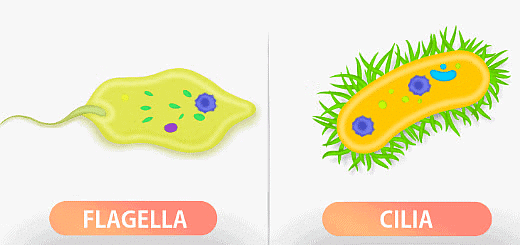 Flagella and Cilia
Flagella and Cilia
- Cilia are hair-like projections, small structures, present outside the cell wall and work like oars to either move the cell or the extracellular fluid.
- Flagella are slightly bigger and are responsible for the cell movements. The eukaryotic flagellum structurally differs from its prokaryotic counterpart.
- The core of the cilium and flagellum is called an axoneme, which contains nine pairs of gradually arranged peripheral microtubules and a set of central microtubules running parallel to the axis.
- The central tubules are interconnected by a bridge and are embedded by a central sheath.
- One of the peripheral microtubular pairs is also interconnected to the central sheath by a radial spoke. Hence there is a total of 9 radial spokes.
- The cilia and flagella emerge from centriole-like structures called basal bodies.
To practice the questions of "Plastids, Cilia & Flagella", attempt the tests given below:
12. Centrosome and Centrioles
 Centrosome and the alignment of the chromosomes during metaphase
Centrosome and the alignment of the chromosomes during metaphase
- The centrosome organelle is made up of two mutually perpendicular structures known as centrioles. Each centriole is composed of 9 equally spaced peripheral fibrils of tubulin protein, and the fibril is a set of interlinked triplets.
- The core part of the centriole is known as a hub and is proteinaceous. The hub connects the peripheral fibrils via radial spoke, which is made up of proteins.
- The centrioles from the basal bodies of the cilia and flagella give rise to spindle fibres during cell division.
13. Vacuoles
- Vacuoles are mostly defined as storage bubbles of irregular shapes which are found in cells. They are fluid-filled organelles enclosed by a membrane.
- The vacuole stores the food or a variety of nutrients that a cell might need to survive.
- In addition to this, it also stores waste products. The waste products are eventually thrown out by vacuoles. Thus, the rest of the cell is protected from contamination.
- The animal and plant cells have different sizes and numbers of vacuoles. Compared to animals, plant cells have larger vacuoles.
 Vacuoles
Vacuoles
A Brief Summary on Cell Organelles


To practice questions on "Cell Organelles", attempt the test given below:
Important Question on Cell Organelles
Q. Which cell organelle is called the Powerhouse of the cell?
Ans. Mitochondria is the cell organelle and is called the Powerhouse of the cell as they carry out the cellular respiration and generate the energy molecules called ATP or Adenosine Triphosphate.
Q. Where do we find Chloroplasts and Chromoplast pigments in plants?
Ans. Chloroplasts and Chromoplasts are the plastids present in all plant cells. Chloroplasts are the green colour pigments, present in the leaves, green-coloured stems, etc. Chromoplasts are the colourful pigments present in all colourful parts of the plant like flowers and fruits, etc.
Q. Why Lysosomes are known as suicide bags?
Ans. Lysosomes are called the suicidal bags because they are capable of breaking down or digesting all the wastes, dead and damaged cells.
Q. What is Nucleoid?
Ans. Nucleoid is a non-membrane, irregular shaped cell organelle present in all prokaryotic cells. They are the carriers of the genetic material of a cell.
|
226 videos|247 docs|150 tests
|
FAQs on Cell Wall and Endomembrane System - Biology for ACT
| 1. What is the function of the cell wall in a cell? |  |
| 2. How does the cell membrane contribute to the endomembrane system? |  |
| 3. What are the different types of organelles found in a cell? |  |
| 4. Can you provide examples of cell organelles and their functions? |  |
| 5. How do modifications in the endomembrane system contribute to cellular functions? |  |





















